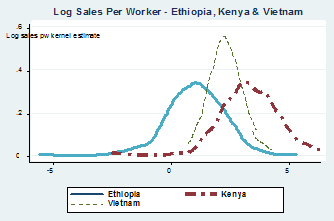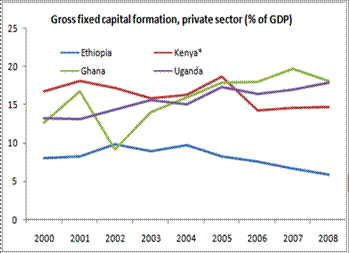From: Berhane Habtemariam (Berhane.Habtemariam@gmx.de)
Date: Fri Dec 04 2009 - 06:53:43 EST
Op-ed: Is Ethiopia in a low productivity trap?
The author is Ken Ohashi, the World Bank's Country Director for Ethiopia and
Sudan
http://web.worldbank.org/shared/images/shim.gif
http://web.worldbank.org/shared/images/shim.gif
ADDIS ABABA, December 4, 2009 -- The World Bank recently completed a second
"Investment Climate Assessment" (ICA) report for Ethiopia. The ICA looks at
the state of the private sector and identifies actions that can reduce
policy and other hurdles to helping the private sector become the driver of
sustained growth. The first ICA was based on a survey conducted in 2001/02
and this one is based on a new survey of about 600 firms in 2006/07. A big
part of the survey is about the "perceptions" of business managers. Hence
it is easy to dismiss the findings as merely someone's opinion. To do so,
however, would seem hasty for two reasons. First, perceptions do matter,
especially when they are those of the entrepreneurs critical to a vibrant
and growing economy. Second, the ICA also looks at a range of hard data to
form a more sophisticated understanding of the problems. So, what does the
latest ICA say?
In 2001/02, firms reported a range of serious obstacles, including poor
infrastructure, regulatory barriers, administrative obstacles, and access to
land and finance. By 2006/07, most of them had become insignificant
problems. The Government of Ethiopia (GoE) has done much to bring about
this change. Yet, the growth of the private sector has remained anemic,
particularly in manufacturing. Given that Ethiopia's wages are about
one-third the average of Sub-Saharan Africa, and that Ethiopia has a big
domestic market with nearly 80 million people, the puzzle becomes more
confounding.
One chart seems to hold a key to this mystery. (If you find a chart like
this confusing, please bear with me. The text will explain the basic idea.)
It plots the productivity of the average worker in different firms for
Ethiopia, Vietnam, and Kenya. The horizontal axis shows the productivity
level and the height of the curve shows the concentration of firms at any
given level of productivity. Two points stand out. First, the average for
all firms (which is somewhere around the peak) is the lowest for Ethiopia.
Second, the distribution of productivity levels among Ethiopian firms is
very wide, especially compared to the distribution for Vietnam. In Vietnam,
competition drives low-productivity firms out of business or forces them to
become more productive. The technology of the most productive firms is
replicated by its competitors. That makes most firms similarly productive
(hence the tall and narrow curve). By contrast, in Ethiopia, the chart
suggests that a lack of competition allows many firms with low productivity
to survive, and that learning from the best firms is limited. This keeps
the overall productivity level of the economy low.
http://siteresources.worldbank.org/INTETHIOPIA/Images/story-Ethiopia_2009120
3a.gif
The relatively nascent nature of the private sector in Ethiopia, after the
repression under the Derg, is surely part of the explanation for the low
productivity. But, if the market system works well, then key factors of
production (land, labor, and credit) should shift from the firms with low
productivity (those on the left hand side of the bell-shaped curve) to those
with high productivity (those on the right side), thereby increasing overall
productivity even without any technological break-though. That process is
not working well in Ethiopia. For some reason, the market is badly
organized. That hinders competition, and traps Ethiopia in low
productivity. Low productivity means low income.
Several things seem to create complex dynamics that favor certain types of
firms regardless of their productivity. First, access to finance is driven
in large part by government policy or collateral, rather than the
productivity of a firm, and long-term financing is limited (which also makes
it difficult to introduce new technology). Second, businessmen lack
confidence that contract disputes can be rapidly and equitably resolved.
Because of this, transactions between firms tend to be based on long-term
relationships, which are less dependent on individual contracts. This
stifles innovation. Third, access to land is often limited for small,
start-up firms. Fourth, GoE's industrial policy tends to channel resources
to a few priority sectors. Fifth, the existence of "endowment companies"
hinders open and fair competition. Sixth, there are regulatory barriers to
entry for a substantial number of economic activities.
This is not to say GoE should not promote businesses of strategic
importance, nor to say GoE should not regulate private companies. The point
is to do so without sacrificing competition. But, at the moment, the
investment climate (which largely consists of institutional characteristics
of the economic system, physical environment, and a set of government
policies) is skewed toward selective promotion of businesses and regulation
at the expense of competition. This imbalance leads to the low productivity
of Ethiopian firms. But, it also shows up in another very direct way,
aggregate private investment in the economy. The second chart shows private
investment as a percentage of GDP for Ethiopia and three other African
countries. The low level of, and more importantly sluggish growth of,
private investment in Ethiopia is striking.
http://siteresources.worldbank.org/INTETHIOPIA/Images/story-Ethiopia_2009120
3b.gif
* For Kenya, the figures are for private investment, and from national
source, while for others they are for gross fixed capital formation, from
World Development Indicator.
Public discussions on the findings of the new ICA have confirmed that the
key concerns raised by it remain relevant. I believe this process has
identified a set of issues that should form a shared agenda to be addressed
jointly by the GoE and the private sector.
* Increasing effective competition is central to raising productivity.
Concerted efforts need to be made to address the complex web of obstacles to
competition. In describing the problem and identifying possible solutions,
open and honest dialogue between the GoE and the private sector is
indispensable.
* Many industries seem to be segmented (into a state-owned segment,
endowment-owned segment, "policy priority segment," foreign segment, etc.).
This seems to limit effective competition. While the discussion on this
issue tends to take on a political overtone, it need not. It is a policy
issue of fundamental importance, for the weak competition is the central
concern. This needs to be openly discussed.
* The financial system must be more effective. The lack of long-term
financing holds back the growth of the private sector as well as competition
and productivity. Given the need to sustain growth, the time has come to
find practical solutions to this old problem. Ethiopia also needs to expand
vastly its rural financial network to encourage savings, and channel those
savings into productive uses and expand credit access in the rural areas.
* The industrial policy regime needs adjustments. It has to be able
to promote a much wider range of industries, not just a few as was done in
the past.
* Diaspora Ethiopians can play an important role in increasing
productivity in this country, bringing not just financial resources but
innovative ideas. There has been much talk of supporting their engagement
back home. It is time to translate talk into action.
* Improving corporate governance deserves attention. Part of the
reason why long-term financing is difficult to come by and firms tend to shy
away from new business relationships is poor corporate governance.
Regardless of the ownership structure, Ethiopian businesses should strive to
improve transparency in their corporate governance and financial reporting.
Competition is scary; it suggests some companies losing out and going out of
business. Actually, most may well survive by improving productivity. It is
not a zero-sum game, for the market for Ethiopian firms can continue to
expand both in Ethiopia and elsewhere. But, without effective competition,
it is almost certain that Ethiopia's productivity growth will remain slow.
That is not a viable strategy.

